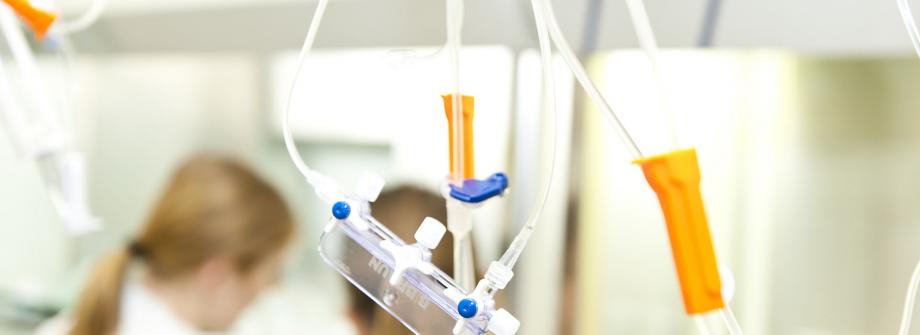
March 2020 Clinical Case of the Month
Title: Dose adjustment in obesity
Submitted by: Syed Ali Abutalib and Nicolaus Kröger
Physicians expert perspective: Claudia Langebrake
40-year-old male with relapsed chemosensitive Hodgkin lymphoma. His body surface area (BSA) is 3 (weight and height, 218 kg and 69 inches, respectively) with normal renal function. He has achieved second complete remission (CR2) after 2 cycles of bendamustine and brentuximab (BB). Plan is to proceed with high-dose BEAM (carmustine, etoposide, cytarabine, and melphalan) with autologous hematopoietic progenitor cell rescue about 2 to 3 weeks following peripheral blood CD34+ cell collection.
What weight would you use to calculate the dose for carmustine, etoposide, cytarabine, and melphalan?
Select one of the best answer:
A. Total body weight (TBW)
B. Ideal body weight (IBW)
C. Adjusted body weight (ABW)
D. A and B
E. A and C
Expert Perspective by Claudia Langebrake
Obesity (defined as BMI ≥ 30 kg/m2) is associated with physiological changes that can alter the pharmacokinetic parameters of many drugs. The American Society for Blood and Marrow Transplantation (ASBMT; now renamed as American Society of Transplantation and Cellular therapy [ASTCT]) reviewed the published literature on dosing of pharmacologic agents used for hematopoietic cell transplantation (HCT) preparative regimens in obese patients in 2014. They concluded that dose adjustments were usually performed empirically or have been extrapolated from published data in non-transplant patients.[1]For cytarabine, etoposide and melphalan (BSA-based dosing), ASTCT recommends to use TBW, while for BSA-based dosing of carmustine, total body weight (TBW) should be used, unless TBW is more than 120% of ideal body weight (IBW). In the latter scenario, the use of adjusted body weight (ABW) for dose calculation is recommended. It has to be taken into account that different formulas for calculating ABW exist: while for chemotherapy, usually 25% of the difference between TBW and IBW is added to the IBW (ABW25), for antibiotics 40% of the difference (ABW40) is added.
In contrast, a single-center retrospective study in obese patients with lymphomas receiving high-dose BEAM revealed that no weight-based dose modifications are required.[2] This was supported recently (2019) by another large multi-center retrospective study which included patient with multiple myeloma and lymphomas across U.S centers (2008-2014) The study demonstrated that most obese patients (approximately 78% of the patients) received dose-adjusted high-dose melphalan (multiple myeloma, n= 1324 of 1696) or BEAM (Hodgkin or non-Hodgkin lymphoma, n=609 of 1781) as conditioning prior to autologous HCT, which did not appear to influence regimen-related toxicity. In multivariate analyses for MM, adjusting for melphalan dose and for center effect had no impact on overall survival (P = .894) and treatment-related mortality (TRM) (P = .62), progression (P = .12), and progression-free survival (PFS; P = .178). In multivariate analyses for lymphoma, adjusting chemotherapy doses did not affect survival (P = .176), TRM (P = .802), relapse (P = .633), or PFS (P = .812). However, the higher risk of early relapse in those who received dose-adjusted chemotherapy possibly reflects the loss of intensity of the conditioning regimen on disease control. Therefore, adjusting doses in obese patients cannot be supported with these data.[3]
On the other hand, the approach to use ABW by 20%-based BSA for dose calculation of melphalan prior to autologous HCT in multiple myeloma has been shown to be non-inferior as compared to the non-obese population in terms of 3-year event-free survival.[4]
Taken together, there are strong signals that weight-based dose adjustments in obese patients receiving high-dose BEAM with autologous HCT are not advisable.
Correct Answer – A (or E according to ASTCT 2014 recommendations). Readers are encouraged to review all the references especially # 3
References
1. Bubalo, J., et al., Conditioning chemotherapy dose adjustment in obese patients: a review and position statement by the American Society for Blood and Marrow Transplantation practice guideline committee. Biol Blood Marrow Transplant, 2014. 20(5): p. 600-16.
2. Fair, C., et al., BEAM conditioning is well-tolerated and yields similar survival in obese and non-obese patients with lymphoma: no requirement for weight-based dose modifications. Bone Marrow Transplant, 2017. 52(3): p. 491-493.
3. Brunstein, C.G., et al., Effect of Conditioning Regimen Dose Reduction in Obese Patients Undergoing Autologous Hematopoietic Cell Transplantation. Biol Blood Marrow Transplant, 2019. 25(3): p. 480-487.
4. Shultes, K.C., et al., Impact of Dose-Adjusted Melphalan in Obese Patients Undergoing Autologous Stem Cell Transplantation. Biol Blood Marrow Transplant, 2017.
Contacts
Syed Ali Abutalib, MD
Associate Director, Hematology and Cellular Therapy Program
Director, Clinical Apheresis Program
Cancer Treatment Centers of America, Zion, Illinois
Associate Professor, Rosalind Franklin University of Medicine and Science
Email: abutalib110@gmail.com
Nicolaus Kröger, MD
Professor and Medical Director of the Department of Stem Cell
Transplantation at the University Hospital Hamburg-Eppendorf, Germany
University Hospital Hamburg, Hamburg, Germany
Correspondence: Nicolaus Kröger, MD
Email: nkroeger@uke.uni-hamburg.de
Expert Perspective
Claudia Langebrake, PhD
Clinical Pharmacist at the Department of Stem Cell
Transplantation and the Hospital Pharmacy at the University Hospital Hamburg-Eppendorf, Germany
University Hospital Hamburg, Hamburg, Germany
Future Clinical Case of the Month
If you have a suggestion for future clinical case to feature, please contact Nicolaus Kröger.